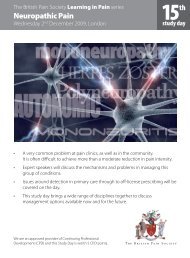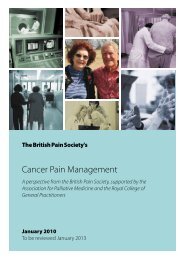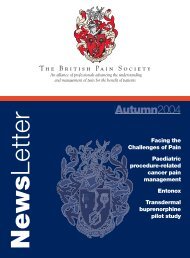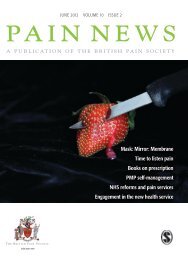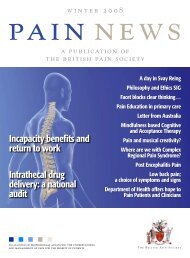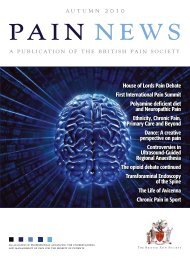Summer 2010 - The British Pain Society
Summer 2010 - The British Pain Society
Summer 2010 - The British Pain Society
Create successful ePaper yourself
Turn your PDF publications into a flip-book with our unique Google optimized e-Paper software.
I have to say that I can see no<br />
'good' reason to support the<br />
persistence of diamorphine<br />
usage in the UK. I put 'good'<br />
in apostrophes because I admit<br />
it's a value judgement (there’s<br />
no Cochrane-level review to<br />
fall back on, sadly), but I have<br />
tried to take a critical look at the<br />
evidence base for the choices,<br />
especially for palliative medicine.<br />
My overall impression is that many<br />
of the diamorphine aficionados in<br />
palliative care are, in my opinion,<br />
guided more by tradition and<br />
misplaced concept of familiarity<br />
taking precedence over innovation<br />
and evidence. So why does<br />
diamorphine hold this special<br />
place in palliative care?<br />
(<strong>The</strong>re is also a case made for<br />
its use in <strong>British</strong> anaesthetics,<br />
but from my reading of that and<br />
discussion with anaesthetists<br />
both within the UK and outside<br />
it, the scientific arguments for<br />
continuation of diamorphine for<br />
the spinal route are not rock-solid<br />
– but more on that later.)<br />
<strong>The</strong> tradition/familiarity argument<br />
basically states that because<br />
we've been doing something for<br />
the last four decades, it must be<br />
right. In my opinion, this is a very<br />
poor reason to block progress<br />
in medicine and I can't see that<br />
principle being applied anywhere<br />
else than in (<strong>British</strong>) end of life<br />
care. Let’s go back to where it<br />
started. Diamorphine was the<br />
drug of choice at St Christopher's<br />
in the early 1970s until Dr Robert<br />
Twycross, even then, showed that<br />
it was no better than morphine.<br />
I quote from his seminal paper<br />
(one of the first randomised<br />
double-blind controlled trials<br />
in palliative medicine) – “A<br />
controlled trial of diamorphine<br />
(diacetylmorphine, heroin) and<br />
morphine is reported in which<br />
the two drugs were administered<br />
regularly by mouth in individually<br />
determined effective analgesic<br />
doses... 699 patients entered the<br />
trial and, of these, 146 crossed<br />
from diamorphine to morphine,<br />
or vice versa, after about two<br />
weeks using an oral potency ratio<br />
of 1.5/1 determined in a pilot<br />
trial... In the female crossover<br />
patients, no difference was noted<br />
in relation either to pain or the<br />
other symptoms evaluated. On<br />
the other hand, male crossover<br />
patients experienced more pain,<br />
and were more depressed,<br />
while receiving diamorphine....<br />
It is concluded that, provided<br />
allowance is made for the<br />
difference in potency, morphine<br />
is a satisfactory substitute for<br />
orally administered diamorphine.<br />
However, when injections are<br />
necessary, the greater solubility<br />
of its hydrochloride gives<br />
diamorphine an important<br />
practical advantage over<br />
morphine, especially when large<br />
doses are required.” (Twycross<br />
1977)<br />
Thus, oral diamorphine was<br />
found to be equivalent to oral<br />
morphine – or actually worse for<br />
males – but because of its greater<br />
solubility (which is actually only<br />
important for large doses given<br />
by the parenteral route), it was<br />
recommended over parenteral<br />
morphine. Which could have<br />
been the final word on the<br />
subject – until alternatives to<br />
both morphine and diamorphine<br />
became available in the following<br />
decades.<br />
Twycross’ introduction reveals<br />
more fascinating insight into the<br />
thinking in palliative care in the<br />
1970s - “Moreover, diamorphine<br />
has been the strong analgesic of<br />
choice at St. Christopher's Hospice<br />
since its inception in 1967 on the<br />
grounds that it: (1) causes less<br />
nausea and vomiting; (2) often<br />
results in a return of appetite<br />
when given to patients with<br />
anorexia; (3) is less constipating;<br />
(4) enhances the mood of the<br />
patient whereas morphine not<br />
infrequently causes dysphoria; (5)<br />
results in a patient who is more<br />
alert, active and cooperative.”<br />
Oddly for such a well-researched<br />
paper, none of these assertions<br />
about the ‘advantages’ of<br />
diamorphine are referenced.<br />
So they probably represent the<br />
opinion of hospice workers<br />
amassed over the previous ten<br />
years – evidence grade IV, we<br />
would say now. And interestingly<br />
enough, reduced nausea is one<br />
of the advantages of diamorphine<br />
cited by the Home Office in its<br />
consultation document. I cannot<br />
find any authoritative source<br />
for that, or the other alleged<br />
advantages, apart from the greater<br />
water solubility.<br />
<strong>The</strong> only evidence I'm aware<br />
of, that diamorphine may do<br />
something ‘special’ as an opioid<br />
analgesic is from the laboratory<br />
of Gavril Pasternak in New York.<br />
(Rossi et al, 1996) This group<br />
identified a novel opioid receptor<br />
to which diamorphine appeared<br />
to be a direct ligand, that was<br />
distinct from the mu-opioid<br />
receptor (MOR) that was bound<br />
by morphine. However, this new<br />
splice variant of the MOR was<br />
also bound by fentanyl and the<br />
morphine metabolite M-6β-G,<br />
so even this was not a ‘unique’<br />
property of diamorphine. As far as<br />
I know nobody else has replicated<br />
this finding and all the other<br />
evidence is that diamorphine only<br />
works when it is de-acetylated to<br />
morphine and then targets the<br />
classical MOR. With diamorphine<br />
we are therefore only using<br />
a rapidly absorbed version of<br />
morphine.<br />
<strong>The</strong> issue about water solubility<br />
is interesting. In the palliative<br />
care world the key issue is for<br />
use in subcutaneous injections<br />
and infusions. Sometimes it is<br />
both necessary and acceptable<br />
to use fairly high doses of opioid<br />
for these. (However, we would<br />
now frown on the patients who<br />
still occasionally turn up on<br />
‘thousands’ of milligrams per day<br />
of diamorphine or morphine – we<br />
now understand that in those<br />
cases, there is almost certainly<br />
a large degree of tolerance and<br />
probably also opioid-induced<br />
hyperalgesia, which ‘feed’ the<br />
vicious circle leading to ever<br />
higher doses. (Chu et al, 2006;<br />
Fallon, Colvin, 2008; Mao, 2008).<br />
Up till 2009, I could not argue<br />
against the superior solubility<br />
of diamorphine – and with<br />
heavy heart (!), I actually had<br />
to convert some of my patients<br />
from morphine or oxycodone<br />
infusions to diamorphine for<br />
just this reason. But since last<br />
year we have oxycodone in high<br />
concentration (50mg/ml) - and so<br />
that major argument in favour of<br />
diamorphine is now history. In the<br />
past year I have never had need to<br />
convert a patient to diamorphine<br />
for the sake of fitting the dose<br />
of opioid into a Graseby syringe<br />
driver.<br />
Admittedly the high strength<br />
oxycodone costs more, but in<br />
fact the current perverse situation<br />
caused by the monopoly of the<br />
manufacturer of diamorphine is<br />
that the latter is now actually more<br />
expensive than standard strength<br />
oxycodone or morphine. But even<br />
if oxycodone or morphine were<br />
more expensive than diamorphine,<br />
can we really justify saying that<br />
palliative medicine prescribing<br />
should be determined more by<br />
cost to the NHS/hospice charities<br />
than the quality of care? <strong>The</strong><br />
outcome for patients may well<br />
be better with a more expensive<br />
drug - and there is good enough<br />
evidence that oxycodone causes<br />
less CNS adverse effects like<br />
hallucinations and sedation than<br />
morphine (Mucci-LoRosso 1998;<br />
Reid et al, 2006). In the final<br />
analysis, the cost of oxycodone<br />
concentrate for the last few days<br />
is insignificant in comparison to<br />
all the other costs that the health<br />
service and charities throw at<br />
patients in the last year of life.<br />
For the past 20 years we have<br />
course also been able to use<br />
fentanyl or alfentanil, both very<br />
potent drugs and with, at least for<br />
the former in its transdermal patch<br />
formulation, a very solid evidence<br />
base of superiority over morphine<br />
in terms of adverse effects, patient<br />
convenience and preference<br />
(Ahmedzai, Brooks 1997; Clark<br />
et al 2004; Tassinari 2008). Both<br />
drugs can also be given by the<br />
parenteral route, where they are<br />
acknowledged to be the safest<br />
opioids to use in renal failure,<br />
when diamorphine and morphine<br />
are in fact dangerous on account<br />
of their toxic metabolites.<br />
PAI N N E W S S U M M E R <strong>2010</strong> 43






